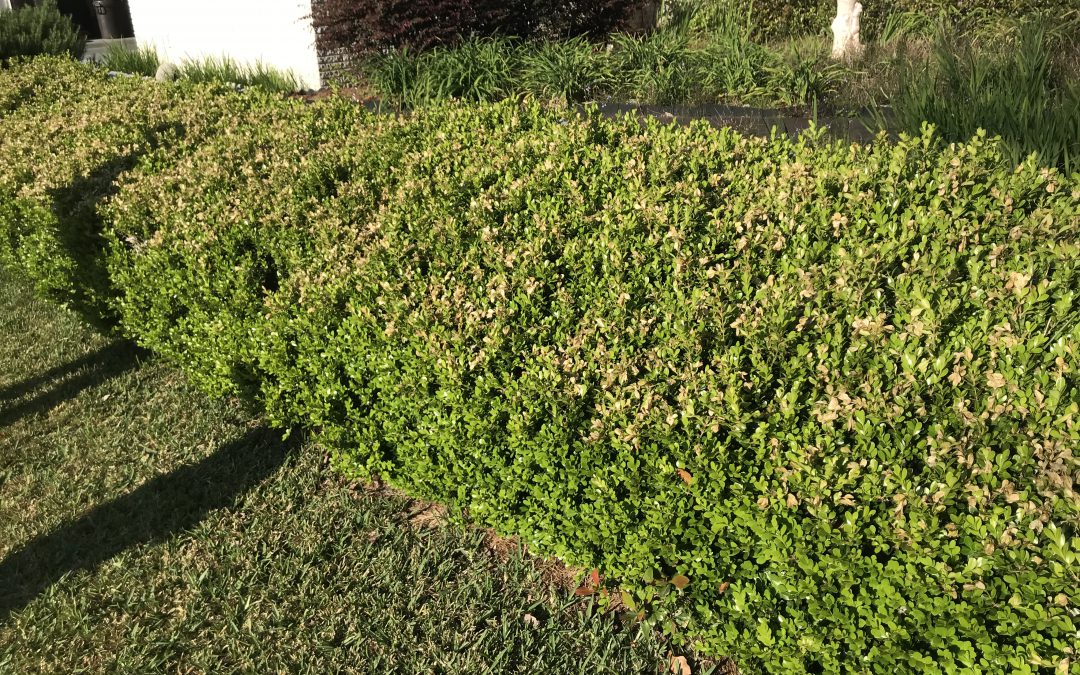
by Daniel J. Leonard | May 20, 2019
Spring is a wonderful time of year. After months of dreariness and bare branches, bright, succulent green leaves and flowers of every kind and color have emerged. So too, have emerged gardeners and outdoor enthusiasts ready to tackle all their home and landscape improvement projects planned over the winter. However, this is also the time, when folks first start paying attention to their plants again, that strange, seemingly inexpiable plant problems crop up!
All plant problems can be divided into two categories: biotic problems, or issues caused by a living organism (think insects, fungus, and bacteria), and abiotic problems, issues that arise from things other than biotic pests. It’s the first category that people generally turn to when something goes wrong in their landscape or garden. It’s convenient to blame problems on pests and it’s very satisfying to go to the local home improvement store, buy a bottle of something and spray the problem into submission. But, in many of my consultations with clientele each spring, I find myself having to step back, consider holistically the circumstances causing the issue to arise, scout for pests and diseases, and if I find no evidence of either, encouraging the person to consider the possibility the problem is abiotic and to adopt patience and allow the problem to correct itself. Of course, this is never what anyone wants to hear. We always want a solvable problem with a simple cause and solution. But life isn’t always that easy and sometimes we must accept that we (nor a pest/disease) did anything wrong to cause the issue and, in some cases, that we ourselves actually caused the problem to happen in the first place! To illustrate, let’s consider two case studies from site visits I’ve had this spring.
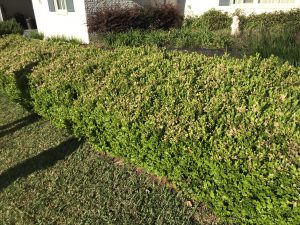
Cold damage on Boxwood hedge
Three weeks ago, I got a call from a very concerned client. She had gotten her March issue of a popular outdoor magazine in the mail, in which was a feature on an emerging pathogen, Boxwood Blight, a nasty fungus decimating Boxwood populations in states north of us. She had also noticed the Boxwoods in front of her house had recently developed browning of their new spring shoots across most the hedgerow. Having read the article and matching the symptoms she’d noticed to the ones described in the magazine article, she was convinced her shrub was infected with blight and wanted to know if there was a cure. Agreeing that the symptoms sounded similar and wanting to rule out an infection of an extremely serious pathogen, I decided to go take a look. Upon inspection, it was obvious that Boxwood Blight wasn’t to blame. Damage from disease generally isn’t quite as uniform as what I saw. The new growth on top of the hedge was indeed brown but only where the eaves of the house and a nearby tree didn’t provide overhead cover and, to boot, the sides of the hedge were a very normal bright green. Having gone through a recent cold snap that brought several mornings of heavy frost and knowing that the weeks before that the weather had been unseasonably warm, causing many plants to begin growing prematurely, all signs pointed toward an abiotic problem, cold/frost damage that would clear up as soon as the plant put on another flush of growth. The client was delighted to hear she didn’t have a hedge killing problem that would require either adopting a monthly fungicide regime or replacing the hedge with a different species.
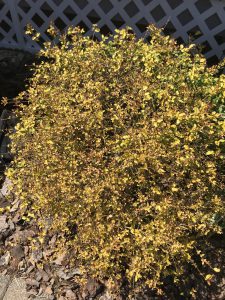
Damage to ‘Sunshine’ Ligustrum from pressure washing siding with bleach.
The very next week, another client asked if I would come by her house and take a look at a hedge of ‘Sunshine’ Ligustrum that lines her driveway, whose leaves had “bleached” out, turning from their normal chartreuse to a bronzy white color. This time, having seen similar issues with this particular plant that almost always involved an infestation of Spider or Broad Mites, I figured this was a cut and dry case that would end with a call to her pest control company to come spray the offending bugs. However, though the leaf damage looked similar, I was not able to locate any existing pests or find evidence any had been around recently, rather it appeared the leaves had been exposed to something that “bleached” and burned them. Puzzled, I began asking questions. What kind of maintenance occurs on the plants? Have you fertilized or applied any chemicals recently? Nothing. Then, near the end of our conversation, the client mentioned that her neighbor had pressure washed their house on a windy day and that she was irritated because some of the soap solution had gotten on her car. Bingo. Leaf burn from pressure washing solution chemicals. This time I was guilty of assuming the worst from a pest when the problem quite literally blew in on the wind from next door. Again, the client was relieved to know the plant would recover as soon as a new flush of growth emerged and hid the burned older leaves!
This spring, I’d encourage you to learn from the above situations and the next time you notice an issue on plants in your yard, before you reach for the pesticides, take a step back and think about what the damage looks like, thoroughly inspect the plants for possible insects or disease, and if you don’t find any, consider the possibility that the problem was abiotic in nature! And remember, if you need any assistance with identification of a landscape problem and want research-based recommendations on how to manage the problem, contact your local UF/IFAS Extension office.

by Mark Tancig | Mar 6, 2019
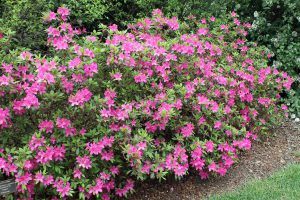
Azaleas are a beautiful shrub for the north Florida landscape, especially if pruned properly. Source: Larry Williams, UF/IFAS
The sight of azaleas in the north Florida spring just makes you feel good. They are so vibrant, and with such variation, that you can’t take your eyes off them. As an appreciator of these beautiful displays of color, nothing pains me more than to see an improperly pruned azalea during this time. If you must prune your azaleas, please, please only prune them once a year and only soon after flowering has ended! This public service announcement will hopefully ensure we all get to see the full azalea show. Otherwise, we’ll be left with mostly green hedges, some flowers uncomfortably tucked in the interior of the plants, or flowers poking out the sides like a middle-aged man’s balding head.
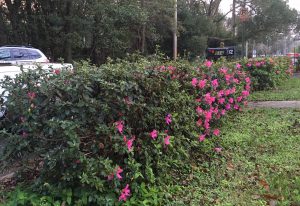
If pruned properly and at the right time, this azalea shrub would be a mass of flowers. Source: Mark Tancig, UF/IFAS.
The common flowering azaleas in landscaped settings are native to Japan and a relative of blueberries. They comprise many different hybrids, cultivars, and varieties of plants in the genus Rhododendron (Greek for rose-tree) and have been cultivated for centuries. Long ago, I’m sure, those who studied plants and tinkered with azaleas realized that their vegetative growth (new leaves and stems) ends soon after flower bud initiation. This means that later prunings, or multiple prunings throughout the year, will be taking off more developing flower buds than new leaf and stem growth.
To prevent depriving us all of less flowers, consider why – or if – they need pruning in the first place. Proper planning and planting can prevent azaleas, which naturally want to be a sprawling shrub, from growing into the sidewalk or driveway. If you’ve inherited azaleas that may be the right plant, but slightly in the wrong place, they can be heavily pruned every couple of years to keep them in check, and can even be transplanted. Azaleas are not a good choice for formal hedges. If given the right place and enough space, the only required pruning would be dead, diseased, or crossing branches.
If you decide you need to prune – whether to knock back for space or for general shape – only bust out the loppers once the flowers have withered on the ground… and then lock those loppers away so that you won’t be tempted. If you have landscapers working for you, remind them to keep the hedge trimmers away from the azaleas.
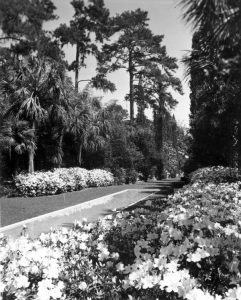
Azaleas are vibrant, even in black and white! Source: Florida State Archives, Florida Memory Project.
For the love of flowers, please prune azaleas thoughtfully, and share this information with others
P.S. We also have several species of native azaleas (including Rhododendron austrinum and Rhododendron canescens) that can be a beautiful addition to the landscape.
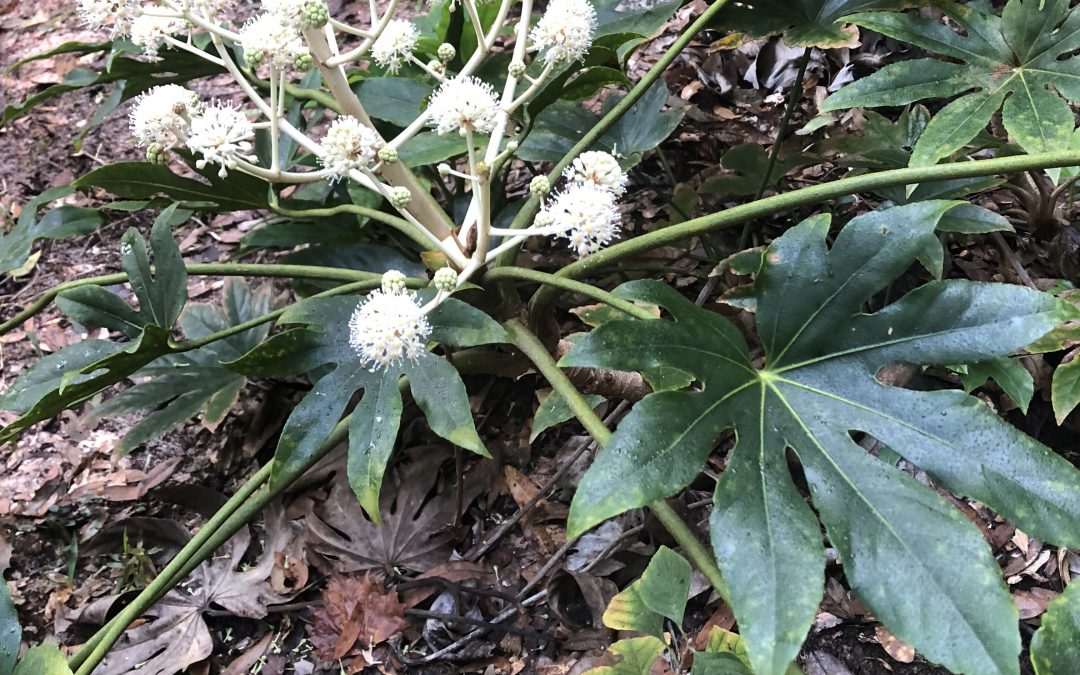
by Matt Lollar | Dec 17, 2018
Fatsia japonica, common name Japanese aralia, provides tropical texture to your landscape. That coarse texture is attributed to its large (nearly a foot wide) leaves that are deeply lobed (maple leaf shaped). This shade-loving plant performs well in moist (not soggy) locations. Upright stems originate near ground level usually near the base of older stems. The stems grow to about eight feet tall before bending toward the ground under their own weight.
Even though the foliage of this species is enough to make you want it in your own garden, you will absolutely fall in love with its blooms. Upright clusters of showy, creamy white flowers begin to appear in fall. These little snowballs provide wonderful color to your garden. The shiny, black fruits appear in winter and are prominent for several weeks. The fruit are know to attract birds to the landscape.
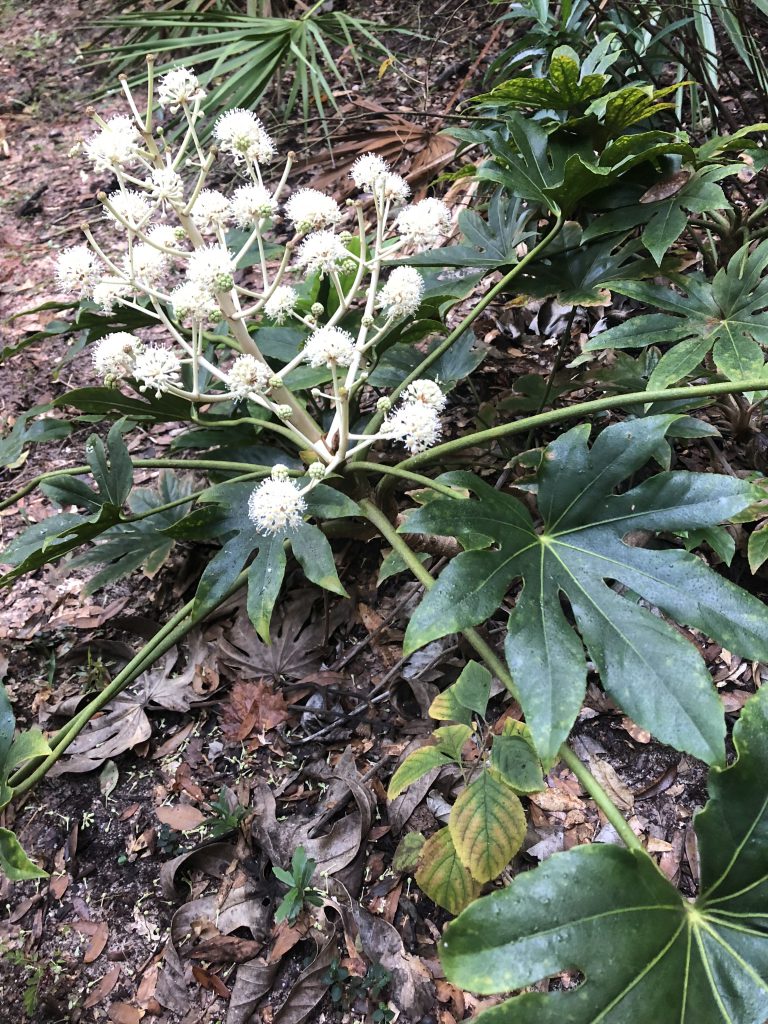
A Fatsia japonica specimen in full bloom. Photo Credit: Matt Lollar, University of Florida/IFAS Extension
Fatsia japonica thrives in the shade in slightly acidic, nutrient-rich, moist soil. Older stems become leggy and can be cut back to encourage branching. In the right place, Fatsia japonica is low-maintenance and not typically bothered by pests. It is also known to perform well in coastal landscapes. It fits well in entryways, in containers, or in mass plantings spaced three feet apart.
by Matt Lollar | Oct 20, 2018
One of my favorite native plants is winged sumac. I like this plant not only for its ornamental beauty, but also for its fruit that can be dried and used as seasoning and to make tea. So you can understand my concern when one of my prized winged sumac plants had distorted leaves.
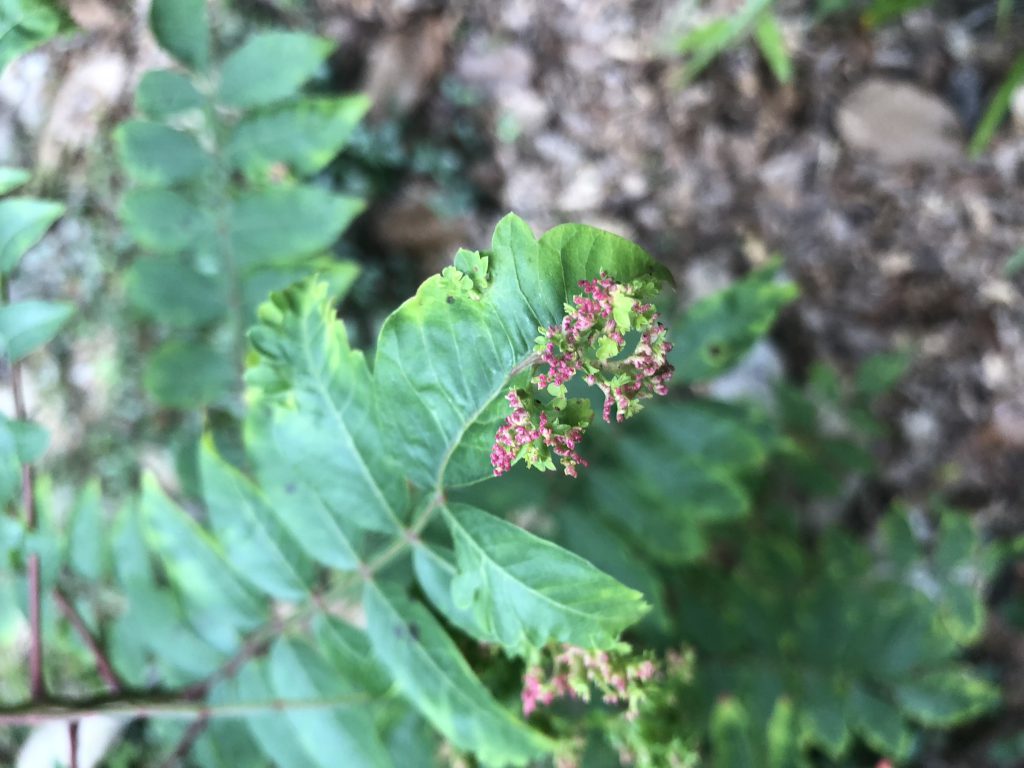
Eriophyid mite damage on winged sumac. Photo Credit: Matt Lollar, University of Florida/IFAS Extension – Santa Rosa County
After doing a little research and speaking with one of our UF/IFAS Specialists, I was able to determine that the leaf distortion was caused by eriophyid mites. Mites are not insects and are more closely related to spiders. They normally have four pairs of legs, however eriophyid mites only have two pairs of legs. They are microscopic, elongate, spindle-shaped, and translucent.

An eriophyid mite. Photo Credit: USDA, Agricultural Research Service.
Eriophyid mites cause galls (sometimes called witch’s broom) on various species of ornamental shrubs. Symptoms include early and late bud distortion, distorted leaves, and possibly plant death. In fact, the species Phyllocoptes fructiphilus is the vector for the viral disease of roses called Rose Rosette Disease. Sometimes the damage can be confused with herbicide damage.
Control options are currently being evaluated for eriophyid mites in the home landscape. Removing distorted plant material and removing it from the site can help prevent the spread of mites. If you suspect eriophyid mites are the cause of your distorted plants then samples should be collected. To collect samples: 1) Prune off symptomatic plant material and immediately place into a vial with rubbing alcohol; 2) label with collection date, plant species, and location; 3) mail to the Landscape Entomology Lab in Gainesville at P.O. Box 110620, Gainesville, FL 32611.
For more information on eriophyid mites and the sampling process, please see the fact sheet “Unusual Galls on Woody Ornamentals” from Erin Harlow and Dr. Adam Dale.
For more information on other mites that could be infesting your landscape, please go to this link from the Mid-Florida Research and Education Center in Apopka, FL.
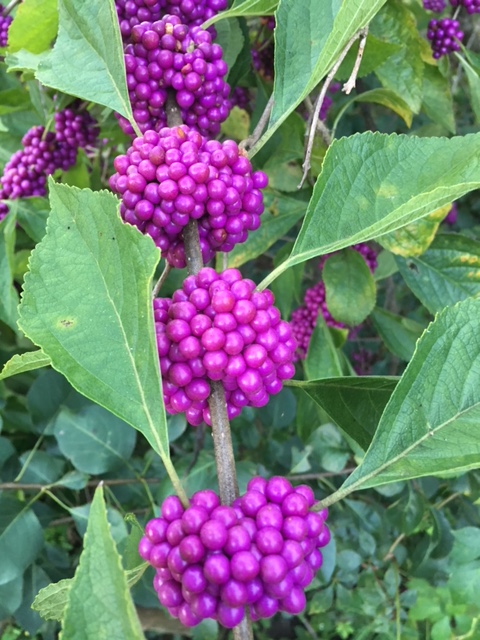
by Larry Williams | Oct 2, 2018
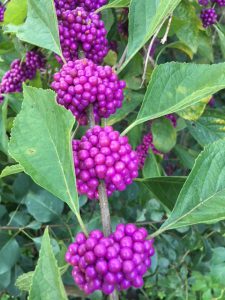
American Beautyberry Fruit.
Photo credit: Larry Williams
American beautyberry (Callicarpa americana) puts on quite a show during late summer and fall with its bright purple fruit. I have some of these plants in my landscape and they are beginning to show color now with their profusion of berry-like fruit found along the thin branches, resulting in the plant taking on a weeping habit.
Each fruit is only about 1/3 inch in diameter but collectively form roundish clusters that encircle the stems. The berries are particularly showy in September and October. They remain on the plant, even after its leaves have dropped, into early winter if not eaten by birds and other wildlife.
Many species of birds will eat beautyberry fruit including robins, cardinals, mockingbirds, brown thrashers, finches and towhees. Birds are a major method of seed dispersal for this plant.
One of my neighbors noticed my plants a number of years ago and commented, “I had never thought about using this plant in a landscape.” He grew up in Northwest Florida and had always been used to seeing American beautyberry plants growing in the wild as they are native. The plant is not well suited for manicured, formal landscapes but can be useful in a naturalized garden.
Even though I consider the showy fruit its best attribute, the small, lavender flowers tightly bunched together along the stems during June to August are attractive, as well.
American beautyberry is a deciduous shrub without much ornamental value during the winter. But during the growing season, its somewhat course, fuzzy, light-green leaves look good in a setting with other darker-leaved shrubs.
It grows well in part shade/part sun as an understory plant beneath larger trees such as pines and oaks.
Be sure to allow enough room for this sprawling shrub to develop into its mature size of three to eight feet in height with an equal spread.
It may also be used as an informal screen or even as a specimen plant. But avoid using it where it will require regular shearing as the flowers and fruit are produced on new growth.
Thinning out old or low-growing branches is a better method of pruning this plant. American beautyberry may self-seed but I have not seen this to be a bothersome problem.
America beautyberry is somewhat available in the nursery trade and is fairly easy to propagate from stem cuttings. It can be propagated from seeds, as well. In addition to the purple fruiting types, look for cultivars such as ‘Russell Montgomery’ that produce white fruit. There are also other nonnative species of Callicarpa worth looking at, such as C. dichotoma and C. japonica.
by Daniel J. Leonard | Jul 3, 2018
Each time I travel to central and south Florida and observe the wonderfully flamboyant tropical flora, I am reminded of the unique and frustrating climatic characteristics of Northwest Florida. Our weather is tropical enough through the summer to sustain virtually everything our friends to the south grow, but winters north of the Big Bend are just cold enough to prevent long-term success with most tropical species. However, the genus that is maybe most synonymous with tropical color, the Hibiscus (it even has its own texting emoji!), contains several species that are hardy through our winters. The best landscape plant of these hardy Hibiscus species is creatively (sarcasm) called Hardy Hibiscus or Giant Rose Mallow (Hibiscus moscheutos) and is an absolute star in the Panhandle, bringing the beauty of the tropics to your yard!
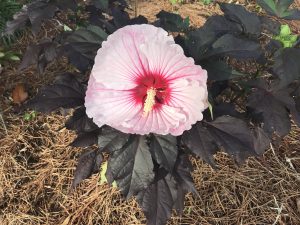
Hibiscus ‘Starry Starry Night’ – Photo courtesy Daniel Leonard
Rose Mallow is a native perennial species that occurs in sunny wetlands across the eastern U.S. This species can grow 7-8’ in height in its natural, unimproved state and possesses the largest flowers of any hardy perennial, some varieties easily eclipse 12” in diameter. Rose Mallows bloom through the heat of our long summers and return reliably each winter unfazed by frost. The flowers also happen to be a favorite of butterflies and hummingbirds and bring beneficial wildlife to the landscape. These characteristics and the trend towards the use of pollinator friendly, low-maintenance native perennials in landscapes quickly made Rose Mallow a jewel for plant breeders and now virtually all major horticultural brands have a line of Hardy Hibiscus available at garden centers, in varying sizes, flower color and leaf color/form. Recent breeding efforts have focused on introducing plants with enormous, richly colored flowers held on compact plants with attractive foliage. The results have yielded two series and three individual cultivars that I consider superior selections and are more than worthy of inclusion in your garden:
- Summerific® Series by Proven Winners. This series is comprised of four robust (up to 5’ in height) cultivars, ‘Cherry Cheesecake’ (bicolor magenta and white flowers), ‘Berry Awesome’ (purplish lavender flowers), ‘Cranberry Crush’ (a red you really have to see to believe), and ‘Perfect Storm’ (notable for its deep purple foliage).
- Luna Series by Monrovia. This series is notable for its ultra-compact (3’ in height or less) size and characteristically large flowers. It is also composed of four cultivars, ‘Luna Red’ (deep red), ‘Luna Blush’ (white, fading to pink near flower margins), ‘Luna Pink Swirl’ (pictured and my favorite, bicolor swirly flowers), and ‘Luna White’ (white with a red center).
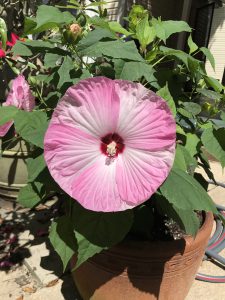
Hibiscus ‘Luna Pink Swirl’ – Photo courtesy Daniel Leonard
- ‘Starry Starry Night’ by Walter’s Gardens. (Pictured) This cultivar combines dark purple to black leaves with swirled pale and dark pink flowers. It has performed very well in my landscape and if I could only grow one, this might be it.
- ‘Lord Baltimore.’ The classic, large growing cultivar with bright red flowers that is widely available and easily found. An oldie (introduced in 1955) but a goodie.
- ‘Midnight Marvel’ by Walter’s Gardens. A “hot off the press” new cultivar that is currently difficult to find due to popularity, though some online outlets have them available in small sizes. This one is worth your patience. Sporting deep red blooms on near black foliage, there’s nothing else like it in the landscape.
In addition to being gorgeous plants, Rose Mallows are extremely versatile in the landscape and could not be easier to grow. Because the size varies so greatly (from the diminutive 30” tall ‘Luna’ series to the 8’ tall unimproved species), there really is a place for one in every garden. I like to use the smaller cultivars in large containers to facilitate moving them around where their floral display has the greatest impact or to create a tropical effect where in ground plantings are not an option (pool decks, patios, etc). The larger cultivars make spectacular specimen plantings in perennial and shrub beds and even make a really dense, striking hedge (just know they disappear in the winter). Be sure to give them as much sun as possible, as this will enhance the number of flowers on each plant and darken the foliage on the cultivars with purplish/black leaves. Too little sun will result in fewer flowers and lighter green foliage. As wetland plants, Rose Mallows enjoy regular water, either from rainfall or irrigation; they will let you know when they need it – their large leaves readily wilt under drought stress, somewhat like Hydrangea.
For low-maintenance, native, pollinator friendly, cold-hardy tropical color, you need look no further than Rose Mallow. These perennial shrubs come in all sizes and colors and fit any landscape! Look for the above listed series and cultivars at better garden centers and online retailers and enjoy the oohs and ahhs elicited when people first get a glimpse of Hardy Hibiscus in your landscape! Happy Gardening!















